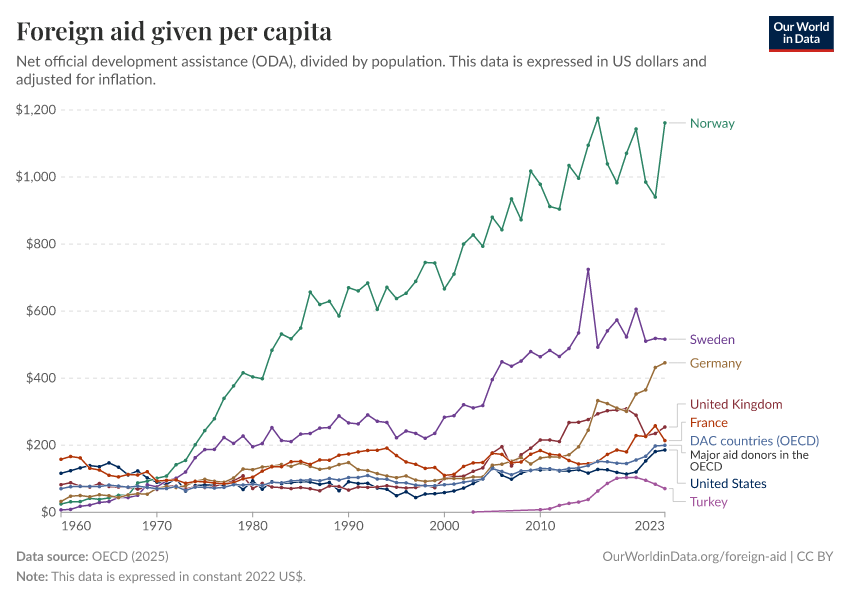Foreign aid given per capita

What you should know about this indicator
- Official development assistance (ODA) is aid given to countries and territories on the OECD Development Assistance Committee (DAC) list of recipients and multilateral development institutions. To qualify as ODA, the aid has to serve the economic development and welfare of recipient countries and be either a grant or a loan with favorable terms.
- DAC country recipients are all low- and middle-income countries as defined by the World Bank, or least-developed countries as defined by the United Nations. All recipients are listed on the OECD website.
- Most ODA is provided by DAC members, which are major aid donors in the OECD plus the European Union. However, some non-DAC countries, such as Turkey or Saudi Arabia, also give aid that follows ODA guidelines.
- ODA does not include military aid, except for the cost of using armed forces to deliver humanitarian aid. It also excludes spending on peacekeeping unless it is closely related to development.
- The data is reported as net disbursements. This refers to aid ultimately given and is different from commitments, which is only aid that has been pledged. These are net amounts because any money coming in (like loan repayments or interest) has been subtracted from money going out (like new grants or loans).
- The OECD adjusts this data for inflation and expresses it in constant 2022 US$. It makes this adjustment using annual average market exchange rates and GDP deflators for each donor country. For more information on the methodology, visit the OECD's documentation on DAC deflators.
What you should know about this indicator
- Official development assistance (ODA) is aid given to countries and territories on the OECD Development Assistance Committee (DAC) list of recipients and multilateral development institutions. To qualify as ODA, the aid has to serve the economic development and welfare of recipient countries and be either a grant or a loan with favorable terms.
- DAC country recipients are all low- and middle-income countries as defined by the World Bank, or least-developed countries as defined by the United Nations. All recipients are listed on the OECD website.
- Most ODA is provided by DAC members, which are major aid donors in the OECD plus the European Union. However, some non-DAC countries, such as Turkey or Saudi Arabia, also give aid that follows ODA guidelines.
- ODA does not include military aid, except for the cost of using armed forces to deliver humanitarian aid. It also excludes spending on peacekeeping unless it is closely related to development.
- The data is reported as net disbursements. This refers to aid ultimately given and is different from commitments, which is only aid that has been pledged. These are net amounts because any money coming in (like loan repayments or interest) has been subtracted from money going out (like new grants or loans).
- The OECD adjusts this data for inflation and expresses it in constant 2022 US$. It makes this adjustment using annual average market exchange rates and GDP deflators for each donor country. For more information on the methodology, visit the OECD's documentation on DAC deflators.
Sources and processing
This data is based on the following sources
How we process data at Our World in Data
All data and visualizations on Our World in Data rely on data sourced from one or several original data providers. Preparing this original data involves several processing steps. Depending on the data, this can include standardizing country names and world region definitions, converting units, calculating derived indicators such as per capita measures, as well as adding or adapting metadata such as the name or the description given to an indicator.
At the link below you can find a detailed description of the structure of our data pipeline, including links to all the code used to prepare data across Our World in Data.
Notes on our processing step for this indicator
We calculated this indicator by dividing by the population of the donor country or regional aggregation. The population estimate is available in the OECD dataset.
Reuse this work
- All data produced by third-party providers and made available by Our World in Data are subject to the license terms from the original providers. Our work would not be possible without the data providers we rely on, so we ask you to always cite them appropriately (see below). This is crucial to allow data providers to continue doing their work, enhancing, maintaining and updating valuable data.
- All data, visualizations, and code produced by Our World in Data are completely open access under the Creative Commons BY license. You have the permission to use, distribute, and reproduce these in any medium, provided the source and authors are credited.
Citations
How to cite this page
To cite this page overall, including any descriptions, FAQs or explanations of the data authored by Our World in Data, please use the following citation:
“Data Page: Foreign aid given per capita”, part of the following publication: Bastian Herre, Pablo Arriagada, Simon van Teutem, and Hannah Ritchie (2024) - “Foreign Aid”. Data adapted from OECD. Retrieved from https://archive.ourworldindata.org/20250909-093708/grapher/foreign-aid-given-per-capita.html [online resource] (archived on September 9, 2025).How to cite this data
In-line citationIf you have limited space (e.g. in data visualizations), you can use this abbreviated in-line citation:
OECD (2025) – with major processing by Our World in DataFull citation
OECD (2025) – with major processing by Our World in Data. “Foreign aid given per capita – Net disbursements” [dataset]. OECD, “OECD Official Development Assistance (ODA) - DAC1: Flows by provider (ODA+OOF+Private)” [original data]. Retrieved December 29, 2025 from https://archive.ourworldindata.org/20250909-093708/grapher/foreign-aid-given-per-capita.html (archived on September 9, 2025).